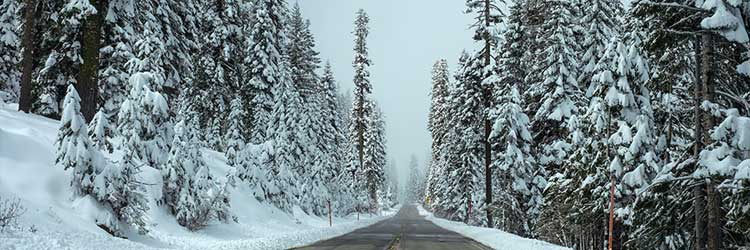Disaster Preparedness: Winter Weather & Blizzards

It's Thursday morning at 5 AM. In the middle of February. You get up, look out the window and all you can see is snow. The wind makes that weird whistling noise as it blows past the windows. You turn on the TV and the smiling anchor is reading off the school closings. And the delayed business openings. And the airport delays. The coffee is on, the snow shovel awaits, and the kids will be ecstatic. Welcome to snowmageddon.
If you live in one of Old Man Winter's favorite locations, it's a familiar scenario. Here are a few tips on how to make sure you're prepared, and make the best of it.
Independent insurance agents can help you get the right coverage for your neck of the woods. But don't wait "till the snow flies" to talk to one.
Before the Winter Season
- Prepare to be cozy. Clean the fireplace and chimney to prepare for fires. Buy firewood and store it well away from the house. Consider buying a generator.
- Prevent water damage. Ice dams can cause serious winter water damage. They’re caused when snow melts on warmer areas of your roof, sending water down to colder eaves, where it refreezes. Multiple bouts of melting and refreezing cause ice to back up under shingles, damaging them. The end result: a leaky roof and interior damage. To minimize the possibility, clear debris from the roof and repair or replace damaged shingles. Verify that the attic insulation is sufficient to prevent ice dams in your area, and if not, upgrade.
- Do not enter. Seal attic entryways, so pests seeking warmth can't get in.
- Go with the flow. Clean gutters and be sure that water will run freely from the roof to the ground.
- Brick home? Patch, seal or repaint masonry as needed to prevent leaks.
- Insulate! Stop heat leaks by caulking and adding or replacing weather strips around windows and doors.
- Prevent ruptured pipes. Shut off water supply to exterior outlets, open the spigots, and drain the pipes. Leave the spigots open for the winter.
- Timber! Trim or remove overgrown, diseased or dead trees or shrubs that could threaten your property should snow or ice cause them to fall.
- Winterize your vehicles. Change to snow tires or all-weather radials, check fluids, battery and hazard lights. Assemble an emergency winter kit for the trunk that includes a flashlight, a battery-operated radio, snacks and water, matches in a waterproof bag, a red cloth to use as a flag, a windshield scraper, a broom, a shovel, a sack of kitty litter or sand, blankets, and traction mats or tire chains.
- Store your water toys. Winterize boat engines and dry dock your boat or other water vehicles. Northerners usually understand the importance of this task, but many Californians have been surprised by freeze-related boat damage.
- Be informed. Purchase a battery-operated or hand-crank portable radio.
Before a Blizzard
- Refill supplies in your emergency kit.
- Be sure to have a week’s worth of medications, medical supplies, and personal hygiene products. Have documentation for medications available.
- Have extra cash on hand.
- Replenish your sand, kitty litter or ice-melting products.
- Make sure you have a full tank of gas in your vehicle.
- Buy fuel for your generator.
- Stock up on batteries.
- Fully charge all rechargeable batteries, portable power banks, cell phones and electronic equipment.
- Stock up on water and nonperishable food that doesn’t need to be cooked. Make sure you have a manual can opener.
- Bring potted plants and pets inside.
During a Blizzard or Extreme Cold

- Monitor the local weather station.
- Stay home. It’s the safest place for you. But if you must go out, use public transportation.
- Keep your pets inside. It’s the safest place for them, too.
- Be ready for a power outage. Turn the heat up in your home while you have power. Make sure flashlights and battery-powered lanterns are working. Prepare a fire in the fireplace, but don’t burn it unless you lose power.
- During a power outage. To avoid carbon monoxide poisoning, be sure any generator or gas grill you use is placed outside, well away from doors and windows. Also, never use the gas stove top or oven for heat or use a propane gas heater inside. Instead, conserve and consolidate heat by congregating in one closed-off room — the one with a fireplace, if you have it. Stuff towels around doors to prevent heat loss. Dress in layers and sleep together. Remember that babies and small children lose heat faster than adults.
- Protect your water source. To help prevent frozen or burst water pipes, turn inside faucets on at a slow drip to keep water flowing. Open doors to kitchen and bathroom closets and below sinks so heated air can circulate and keep the pipes warm.
After a Blizzard
- Take it slow and easy. Don’t overexert yourself while shoveling show. Sweating can lead to hypothermia, and hard labor in the cold may cause a heart attack. Take frequent breaks.
- Be a homebody. Avoid driving until traffic conditions improve. If you do drive and become stranded, stay in your vehicle and wait for help. Tie a red flag to your radio antenna or secure the flag in the driver’s side window outside the door.
What's So Great about an Independent Insurance Agent?
Insurance policies are complex, and searching through options can be confusing, time-consuming and frustrating. An independent insurance agent's role is to simplify the process.
They will make sure you get the right coverage that meets your unique needs and will break down all the jargon so that you understand exactly what you're getting. They’ll help guide you through all your options, weigh the good and the bad, and even see you through it all from start to signature. See, easy, isn’t it?
